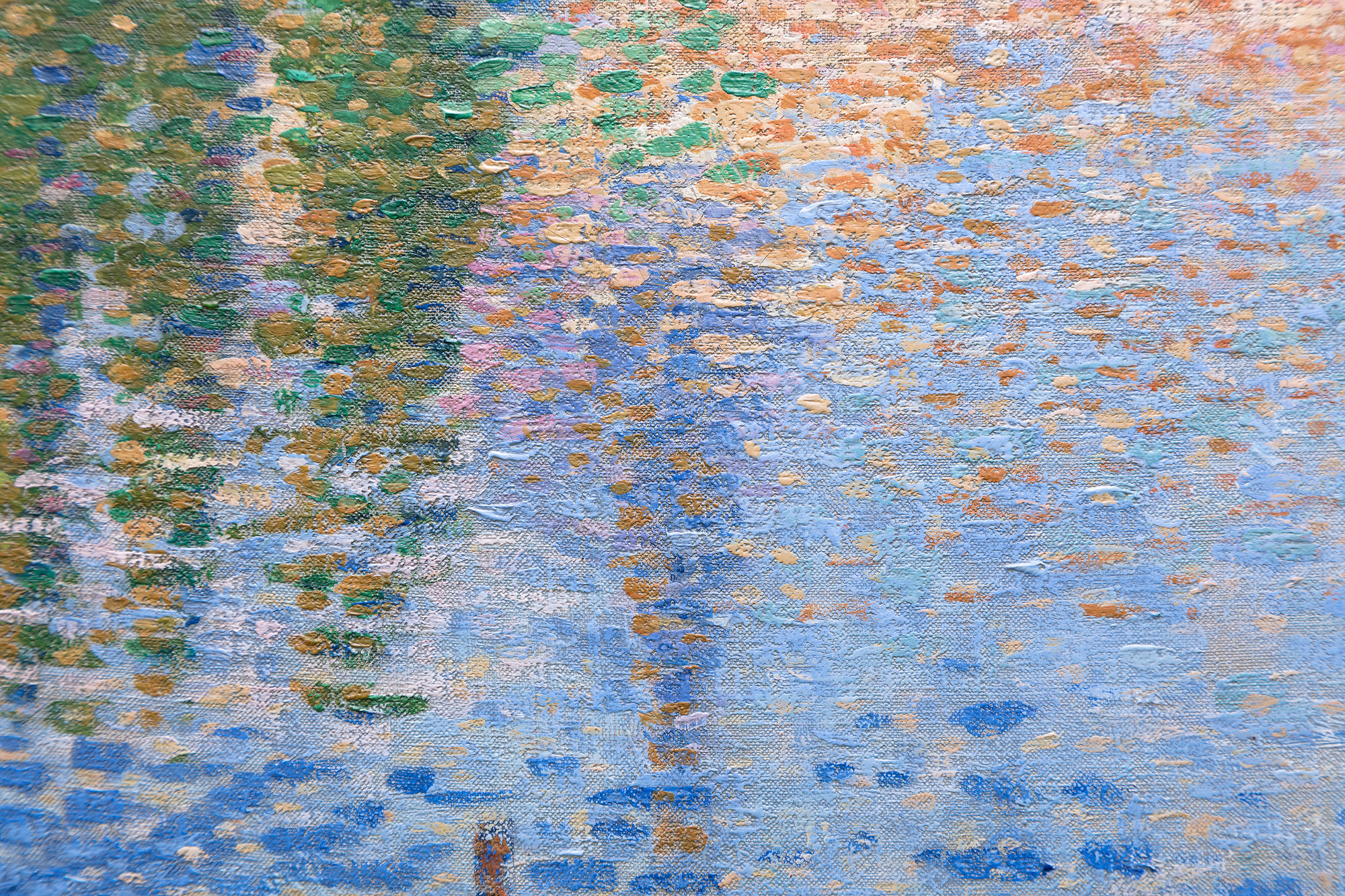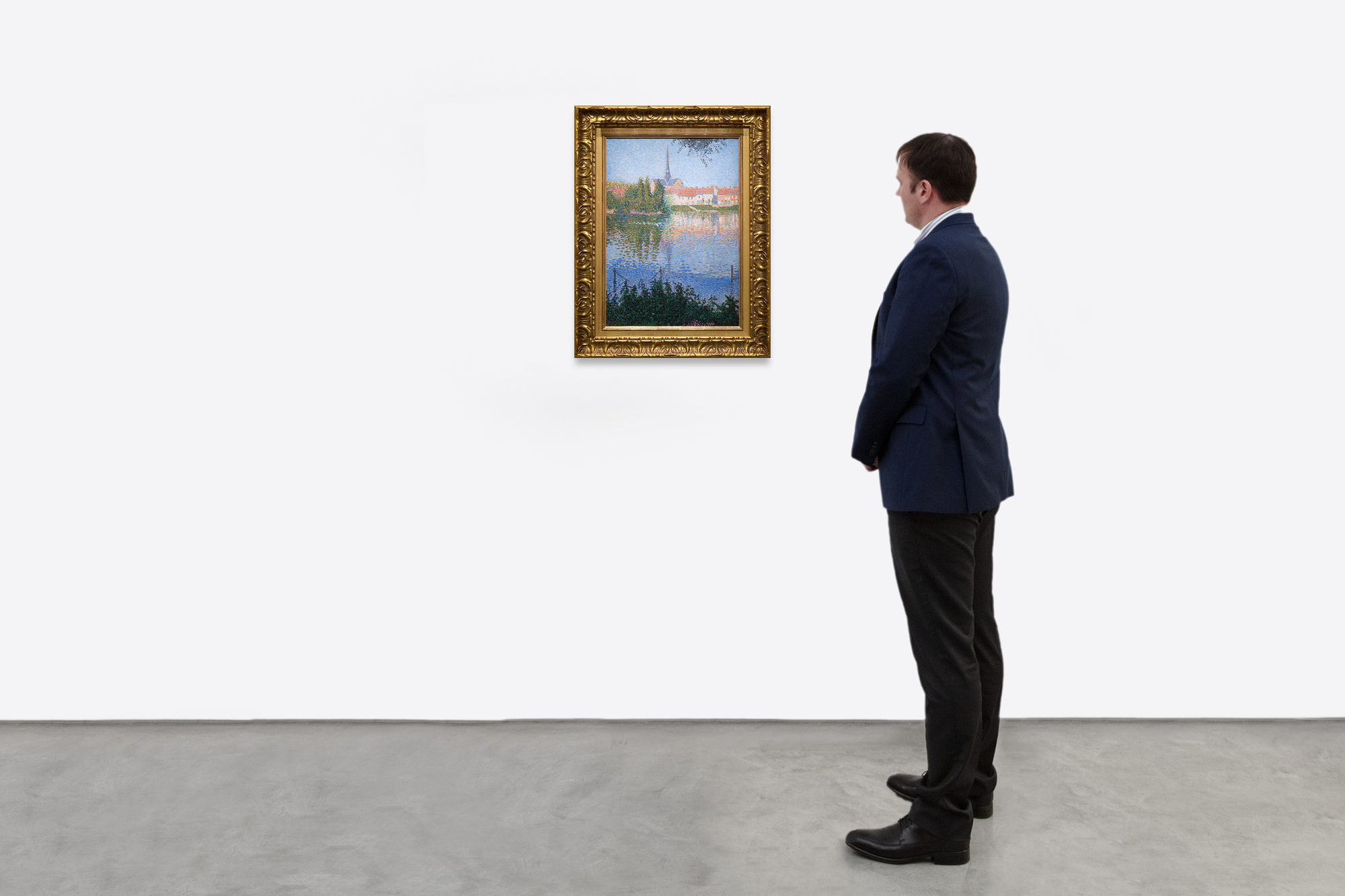PAUL SIGNAC (1863-1935)










Provenance
Charles Torquet (offered to)Gaston Lévy, Paris
Wildenstein & Co., London
Sir Keith Murdoch, Melbourne, 1939
Joel’s Melbourne, 11 - 13 March 1953, lot 244
Private Collection, acquired from the above
Private Collection, by descent from the above
Christie’s, London, 21 March 1983, lot 14
Private Collection
William Vareika Fine Arts, Newport, Rhode Island
Private Collection, 2011
Heather James Fine Art
Exhibition
Salon des Indépendants, 'Exposition de la Société des Artistes I...More...ndépendants', Paris/FR, August 20 - September 21, 1886National Art Gallery, 'Herald Exhibition of French and British Contemporary Art', Adelaide/AU, August - September 1939 (traveled to: Town Hall, Melbourne/AU, October - November 1939)
Minnesota Marine Art Museum, 'on long-term loan', Winona Minnesota, 2013 - 2021
Literature
'Catalogue des oeuvres exposées', Paris/FR: Société des Artistes Indépendants, 1886, no. 366, as 'L’Île à Lucas. Petit Andely. - Juin-Juillet 1886' (exh. cat.)Félix Fénéon, 'Les impressionnistes en 1886', Paris/FR: Éditions de La Vogue, 1886, pp. 39-40
Paul Adam, 'Les artistes indépendants', Paris/FR, in: La Vogue, no. 8, 6-13 Septembre, 1886, p. 263
Émile Hennequin, 'L'Exposition des artistes indépendants', Paris/FR, in: La Vie moderne, 11 Septembre, 1886, p. 582 Félix Fénéon, 'L'impressionnisme aux Tuileries', Paris/FR, in: L'Art moderne, 19 Septembre, 1886, p. 301
Paul Signac, 'Cahier d'opus [Artist's handlist]', 1902, no. 133 (as L'Île à Lucas. Petit Andely')
Paul Signac, 'Cahier manuscrit [Artist's handlist]', 1909, listed
Gaston Lévy, Paul Signac, 'Pré-catalogue', Paris/FR: Gaston Lévy Gallery, 1932, p. 130, listed (pre-catalogue) Basil Burdett, 'Exhibition of French and British Contemporary Art', Adelaide/AU: National Art Gallery, 1939, no. 110, unpag., ill. in b/w (exh. cat.)
Françoise Cachin, 'Signac. Catalogue raisonne de l'oeuvre peint', Paris/FR: Editions Gallimard, 2000, no. 119, p. 174, ill. in b/w (cat. rais.)
Annette Blaugrund (ed.), 'Charting New Waters: Redefining Marine Painting. Masterworks from the Burrichter/ Kierlin Collection', Winona MN: Minnesota Marine Art Museum, 2013, no. 34, pp. 86-87, ill. in colour, p. 113, listed
...LESS...
History
On May 15, 1886, a visual manifesto for a new art movement was born when Georges Seurat’s crowning achievement, A Sunday Afternoon on the Island of La Grande Jatte was unveiled at the Eighth Impressionist Exhibition. Seurat can claim title as the original “Scientific Impressionist” working in a manner that came to be known as Pointillism or Divisionism. It was, however, his friend and the confidant, 22-year-old Paul Signac and their constant dialogue that led to a collaboration in understanding the physics of light and color and the style that emerged. Signac was an untrained, yet a blazingly talented, Impressionist painter whose temperament was perfectly suited to the rigor and discipline required to achieve the painstakingly laborious brushwork and color. Signac quickly assimilated the technique. He also bore witness to Seurat’s arduous two–year journey building myriad layers of unblended dots of color on the colossally-sized La Grande Jatte. Together, Signac, the brash extrovert, and Seurat, a secretive introvert, were about to subvert the course of Impressionism, and change the course of modern art.

Georges Seurat "A Sunday Afternoon on the Island of La Grande Jatte" (1886)
Les Andelys. L’île a Lucas shows Signac at the height of his devotion to pointillist technique and dates to a key moment not only in his art, but in the emergence of Neo-Impressionism. It is a lovely, emotionally restrained painting that emphasizes formal precision, yet its gentle luminosity retains the impression of the painter as poet and creator rather than of the scientist. That said, for many, its optical mixture was as startling as it was a revelation that presented an abject challenge to the instinctive art of the Impressionists. Signac arrived at the twin towns of Les Andelys in early June 1886 following two months living with Camille Pissarro at Éragny-sur-Epte. When the second Salon of the Société des Artistes Indépendants opened on August 21, 1886, Signac, serving on the hanging committee, chose Les Andelys. L’île a Lucas as one of four Les Andelys depictions to be included.
Unlike Seurat, who wrote to Signac that “while you see Les Andelys as colorful, I see the Seine as an almost indefinable gray sea, even under the strongest sun,” Signac was charmed by the beauty of Les Andelys. Having been introduced to sailing by Gustave Cailebotte the previous year, Signac had fallen in love with the river, so it is not surprising that he set his easel across the Seine, directed his gaze to the distant twelfth-century church spire and painted the transparencies and scintillating reflections of the water. In total, Signac painted ten Les Andelys pictures. Most were gifted to friends and relatives likely because he recognized their significance and wanted to keep them within easy reach. Les Andelys. L’île a Lucas was given to his childhood friend, the writer Charles Torquet.
Paul Signac’s outstanding contribution to modern art is often underestimated. In the years following Seurat’s early death in 1891, Signac carried Neo-Impressionist principles forward to influence painters such as Theo van Rysellbergh and Henri Cross. Soon thereafter, he laid the groundwork for the Fauves and Matisse, Braque and Derain. Signac died in Paris in 1935, but his oeuvre stands as a pillar of modern art, his paintings and watercolors all but de rigueur for museums and institution collections throughout the world.
St. Savior Church of Petit-Andely
Les Andelys. L’Île à Lucas is part of the rich art history of Normandy, France. Many painters, including Claude Monet, Alfred Sisley, Camille Pissarro, and Vincent van Gogh, all found inspiration in this scenic French region. Almost immediately after Georges Seurat debuted his masterpiece A Sunday Afternoon on the Island of La Grande Jatte at the Impressionist exhibition in May 1886, Paul Signac moved to the Norman town of Les Andelys for three months.
Les Andelys. L’Île à Lucas is a stunning representation of this important series as it captures the inspiration Signac drew from Pointillism’s developments and the idyllic scenery. Les Andelys. L’Île à Lucas depicts the St. Savior Church of Petit-Andely from across the Seine. The church was built in the 13th century and still stands today.

Paul Signac, "Les Andelys. L'Île à Lucas" (1886)
Signac painted ten landscapes during his summer in Les Andelys, one of which is Les Andelys. L’Île à Lucas. These ten paintings are listed in Françoise Cachin’s catalogue raisonné of Paul Signac’s paintings as numbers 119 to 128 and are considered Paul Signac’s first series of works painted with the contrasting dots and dashes of Pointillism. Today, four of these ten paintings are now in the collections of the Musée d’Orsay, the Nelson-Atkins Museum, the Norton Simon Museum, and the Art Institute of Chicago. Les Andelys. L’Île à Lucas is one of the brightest and boldest artworks Signac painted in Les Andelys during the summer of 1886 and is one of only six privately available paintings from this series.
MARKET INSIGHTS
- According to Art Market Research, since 1976, Signac has had a 9.5% compound annual growth.
- Signac only created 611 paintings, and works of this quality rarely come onto the market. To compare, Claude Monet created approximately 1,900 paintings.
Painted in 1886, Les Andelys. L’Île à Lucas was created during the first of Signac’s two most important artistic phases (the other being the 1905-1908 artworks that highlight the fauvist use of color). The extensive list of publications and exhibitions history of this painting is a testament to its quality and importance.
Les Andelys. L’Île à Lucas arguably exceeds the quality of the Art Institute of Chicago’s “Les Andelys, Côte d’Aval,” also painted in 1886, as well as many other works from this period that have sold at auction.
On November 9, 2022, Christie’s auction of the Paul G. Allen Collection included paintings by Pointillism’s most prominent painters, Paul Signac, Georges Seurat, and Henri-Edmond Cross. The sale set new auction records for each of these artists, signaling the impressive demand for quality paintings from this art historical genre.
On View in Jackson Hole with Tom Venditti
Before joining Heather James Fine Art, Director Tom Venditti served as Senior Director of Art for Paul Allen’s Art Collection, the same collection from which Signac’s Concarneau, calme du matin (Opus no. 219, larghetto) (1891) recently sold for $39,320,000.
Tom brings decades of experience when advising clients. Here, Tom shares insights into the Neo-Impressionist art market’s exciting, recent developments and highlights the characteristics that make Paul Signac’s Les Andelys. L’Île à Lucas (1886) such a compelling Pointillist masterpieces.
Top Results at Auction

"Concarneau, calme du matin (Opus no. 219, larghetto)" (1891) sold for $39,320,000.

"Le Port au Soleil Couchant, Opus 236 (Saint-Tropez)" (1892) sold for $25,970,502.

"La Corne D’Or" (1907) sold for $16,210,000.
Comparable Paintings Sold at Auction

"Cassis. Cap Canaille" (1889) sold $14,041,000.

"Portrieux. La Comtesse (Opus no. 191)" (1888) sold for $13,812,500.

"Arrière du Tub" (1888) sold for $11,688,000.

“Maisons du port, Saint-Tropez” (1892) sold for $10,666,000.
Similar Paintings in Museum Collections
The Art Institute of Chicago
Musée d'Orsay, Paris
The Norton Simon Museum, Pasadena
The Nelson-Atkins Museum of Art, Kansas City
Hiroshima Museum of Art
The Metropolitan Museum of Art, New York
Authentication
Les Andelys. L’Île à Lucas (1886) is listed as number 119 on page 174 in Françoise Cachin’s catalogue raisonné of Paul Signac’s paintings.
The painting’s entry in the catalogue raisonné notes that “the verve of Mr. Signac accentuates his din in his new canvases, landscapes of Andelys – waters and greenery – dated June-July 1886.”
Image Gallery
Inquire
You May Also Like







































_tn45742.jpg )

_tn45734.jpg )
_tn45731.jpg )